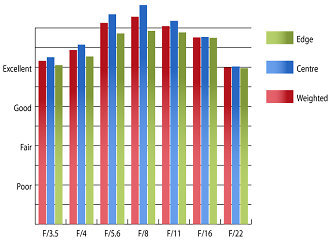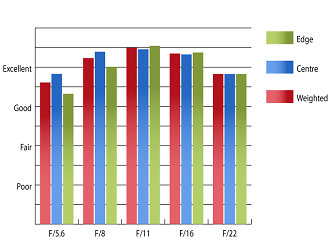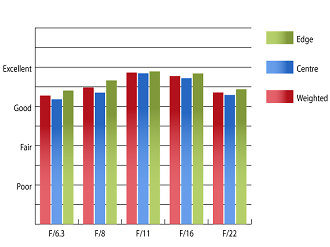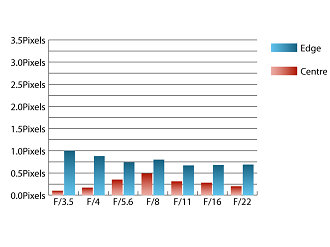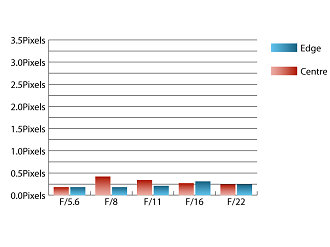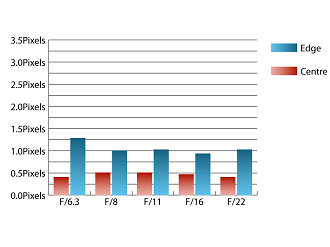Tamron 28-300mm f/3.5-6.3 Di VC PZD Review
Tamron 28-300mm f/3.5-6.3 Di VC PZD Performance
At 28mm and maximum aperture, the sharpness delivered by this lens across the frame is already excellent. Stopping down improves performance across the frame, with peak sharpness being achieved at f/8. Here clarity is outstanding across the frame.
Zooming to 100mm, results in a drop in sharpness to very good levels in the centre of the frame at maximum aperture, and good clarity towards the edges of the frame. Stopping down to f11 provides the best performance across the frame for this focal length, here sharpness is excellent across the frame.
Finally at 300mm, overall performance is reduced a little further, but the lens still holds pretty well, especially for a lens with such a large zoom range. At f/6.3, sharpness reaches good levels across the frame. As is the case with 100mm, f/11 provides the best performance, producing very good levels of sharpness across the frame.
How to read our charts
The blue column represents readings from the centre of the picture frame at the various apertures and the green is from the edges. Averaging them out gives the red weighted column.The scale on the left side is an indication of actual image resolution. The taller the column, the better the lens performance. Simple.
For this review, the lens was tested on a Canon EOS 5D Mark III using Imatest.
Levels of chromatic aberrations are kept within acceptable limits throughout the zoom range, with fringing only exceeding one pixel width at f/6.3 and 300mm. This low level of fringing should pose few issues, even in images with high contrast towards the edges of the frame.
How to read our charts
Chromatic aberration is the lens' inability to focus on the sensor or film all colours of visible light at the same point. Severe chromatic aberration gives a noticeable fringing or a halo effect around sharp edges within the picture. It can be cured in software.Apochromatic lenses have special lens elements (aspheric, extra-low dispersion etc) to minimize the problem, hence they usually cost more.
For this review, the lens was tested on a Canon EOS 5D Mark III using Imatest.
Falloff of illumination towards the corners of the frame is reasonably controlled for a lens of this type. At 28mm the corners are 2.39 stops darker than the image centre and at 300mm the corners are 1.69 stops darker. Visually uniform illumination is achieved with the lens stopped down to f/8 or beyond throughout the zoom range.
As is often the case with super zoom lenses, distortion is noticeable at both ends of the zoom range, although it isn't too intrusive. At 28mm 4.51% barrel distortion is present, which is a noticeable level and at 300mm 1.1% pincushion distortion is present, which is much less apparent. The distortion pattern is uniform across the frame, so any distortion should be fairly easy to correct in image editing software subsequently if required.
A petal-shaped hood is supplied with the lens, which does a respectable job of shielding the front element from extraneous light that may cause flare or loss on contrast. At 300mm, shooting into the light does result in a little loss of contrast, but otherwise, this lens is fairly immune to flare.
Value For Money
This 28-300mm lens costs around £620, which is comparable to Nikon's 28-300mm VR lens, which retails for around £659, although the Nikon optic has a slightly faster f/5.6 maximum aperture at 300mm.
This lens will be of particular interest to owners of Canon or Sony full frame cameras, as neither manufacturer currently offers a similar lens. Well, Canon do offer a 28-300mm f/3.5-5.6L USM lens, but it is huge, heavy and costs around £1900, so it is hardly similar.
Add your message
Please login here or if you've not registered, you can register here. Registering is safe, quick and free.
photodo Stats
428 MTF tests
74 in-depth photodo reviews
100+ users join each day
Help the lens community by reviewing or rating a lens today via our lens search
Latest Lens Reviews
- Chinon 28mm f/2.8 Vintage Lens Review
- Canon EF 70-200mm f/4L IS II USM Lens Review
- Samyang AF 85mm f/1.4 EF Review
- Sigma 70mm f/2.8 DG Macro Art Review
- Samyang AF 24mm f/2.8 FE Review
- Meike 50mm f/1.7 Review
- Tamron 70-210mm f/4 Di VC USD Review
- Lensbaby Burnside 35mm f/2.8 Review
- Asahi Super Takumar 50mm f/1.4 Review
- Asahi Super-Multi-Coated Takumar 135mm f/3.5 Review
